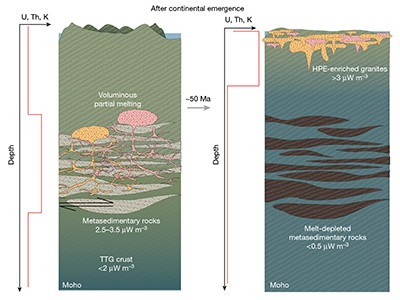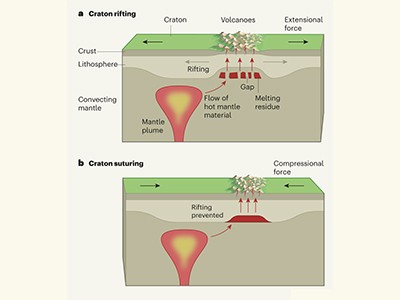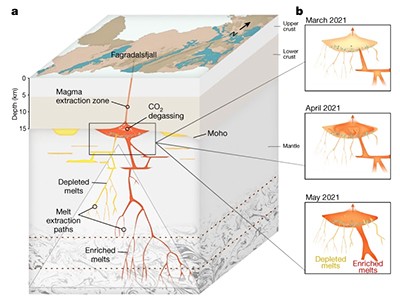Humans live on, and depend on the resources of, Earth’s continental crust — a geological feature that is exclusive to Earth among the Solar System’s rocky planets. The core regions of continental crust are called cratons, and they have remained stable and isolated from tectonic reworking for billions of years; the innermost nuclei of cratons date to the Archaean eon (4 billion to 2.5 billion years ago). How and why these ancient cores formed and stabilized remains unknown. Writing in Nature, Reimink and Smye1 propose an explanation that links the initial stabilization of cratons to the emergence of continents above sea level.
Read the paper: Subaerial weathering drove stabilization of continents
Crucial to the stability of cratons are strong roots. The deepest level of these foundations extends below the crust into mantle keels — distinctively thick layers of cold mantle that have been depleted of melted rock. These robust mantle keels have considerable strength, owing to their cold, melt-depleted nature, and they therefore protect the overlying crust from tectonic modification2.
However, the lower crust of cratons must also remain strong. As with the mantle keels, the strength of the lower cratonic crust has been enhanced by the extraction of melt and by cooling3. Estimates of the vertical distribution of radioactive heat-producing elements (mainly uranium, thorium and potassium) in the continental crust indicate that the deep crust has lower concentrations of these elements than does the upper crust4. In particular, heat-producing elements are concentrated in granites, which are characteristic of the upper crust5.
One potential mechanism for the formation of granites is the melting of rocks in the lower crust. Melting of the lower crust might sound straightforward, but it is not easy for the crust to reach temperatures that exceed the melting point of rocks. The specific melting temperature depends on several factors, including the depth, the type of rock and whether fluids are present, but temperatures higher than 700–800 °C are typically required to melt rocks in the lower crust to a substantial extent6. How can the required heat be generated?
Ancient continental blocks soldered from below
Several answers to this question have been proposed, all of which emphasize the input of heat from the underlying mantle7. However, one issue with these models is that, for many cratons, the formation of the cold mantle keel predates the emplacement of granites in the upper crust2. Thus, in many locations, it seems that the mantle stabilized before the lower crust did.
Reimink and Smye suggest a mechanism for melting the lower crust that does not invoke heating from the mantle. Their hypothesis is simple: if heat-producing elements become concentrated in the lower crust, they could produce sufficient heat over geological timescales to increase temperatures past the melting point of rocks.
To address whether this theory is feasible, the authors first compiled existing data on heat-producing elements in rocks older than 2.5 billion years. They found that Archaean granites and basalts generally had low concentrations of these elements and thus low rates of heat production. By contrast, the heat-production rates of Archaean sedimentary rocks — which formed when the continents first began to emerge above sea level and were then weathered by the atmosphere — were twice as high. The authors’ thermal modelling of thick crust composed of these different rock types demonstrates that only when sedimentary rocks are present in the mid- to lower crust can sufficient heat be generated through radioactive decay to induce melting.
A glimpse into the deepest parts of the Fagradalsfjall volcanic system
Although this study is based mainly on geochemistry and thermal modelling, the proposed model is consistent with the ages and types of rocks observed in cratons. The geological record of every Archaean craton reveals a typical sequence of rock formation. First, beginning between about three billion and four billion years ago, the record is dominated by mafic (rich in magnesium and iron) volcanic rocks and sodium-rich granites8. Then, about three billion years ago, mantle keels began to stabilize2, continental masses emerged above sea level and thick sequences of sedimentary rocks derived from the uplift and erosion of older continental crust were deposited9. Finally, between 2.5 billion and 2.9 billion years ago, depending on the craton, high-temperature metamorphism — transformation of the minerals and textures of rock under conditions different from those of their original formation — in the lower crust occurred at the same time as the intrusion into the upper crust of granites characterized by high concentrations of heat-producing elements.
This last event is the one modelled by Reimink and Smye: the amalgamation of the Archaean cores of cratons, which resulted in a cool, strong lower crust and an upper crust cemented together by late-Archaean granites. Putting the authors’ findings into context with the geological history of cratons, the story that emerges is that the earliest continental masses ensured their own survival by rising above the oceans, shedding the detritus of atmospheric weathering to sedimentary basins and then reincorporating those sediments into the crust (Fig. 1). In essence, this is the first clear evidence for a full circuit of the rock cycle — the continual sequence of transitions in which rock is converted from igneous to sedimentary to metamorphic rock, and back to igneous.

Figure 1 | Proposed model for the stabilization of the lower crust in cratons. Reimink and Smye1 modelled the evolution of Earth’s crust at cratons — the strong and ancient cores of continents. a, The authors suggest that when continents first emerged above sea level about three billion years ago, atmospheric weathering of the land masses resulted in the formation of sedimentary rocks in which radioactive heat-producing elements (HPEs) were highly concentrated. These rocks were then buried and incorporated into the lower crust. b, The concentration of HPEs in the lower crust generated temperatures that resulted in metamorphism (processes that change the mineral content and structure of rocks) and melting. The melt rose to the upper crust, forming granites rich in HPEs, and leaving behind a lower crust that was cold and melt-free. These characteristics stabilized and strengthened the lower crust, thereby helping to protect the craton from modification by tectonic forces.
Reimink and Smye’s model opens up questions for future discussion. For example, why did the concentrations of heat-producing elements in sedimentary rocks increase in the late Archaean and peak between 2.5 billion and 2.0 billion years ago? Notably, Earth was dynamic during this period: not only were the continents stabilizing, but also the first major increase in the levels of atmospheric oxygen occurred, which would certainly have influenced how rocks were weathered. Among the heat-producing elements, uranium is especially sensitive to atmospheric oxygen levels, and becomes mobile in fluids when it is oxidized. The onset of oxidative rock weathering by the atmosphere would therefore have released uranium to marine sedimentary basins10.
Moreover, the redistribution of heat-producing elements during melt extraction is controlled by the behaviour of an array of minerals during melting5. Further detailed studies of late-Archaean high-temperature metamorphic rocks and their derivative granites are required to understand the details of how heat-producing elements were distributed between these rocks11.
In the meantime, these findings add considerably to Earth scientists’ understanding of continent formation. More broadly, they contribute to an ever increasing, transdisciplinary dialogue that aims to construct a holistic understanding of our planet, thereby revealing how changes at the surface affect the dynamics of deep Earth, and vice versa.

 Read the paper: Subaerial weathering drove stabilization of continents
Read the paper: Subaerial weathering drove stabilization of continents
 Ancient continental blocks soldered from below
Ancient continental blocks soldered from below
 A glimpse into the deepest parts of the Fagradalsfjall volcanic system
A glimpse into the deepest parts of the Fagradalsfjall volcanic system







